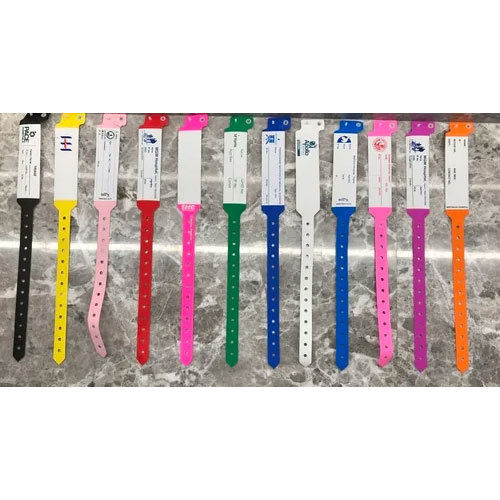A Comprehensive Guide to the Different Types of Patient Identification Band
A Comprehensive Guide to the Different Types of Patient Identification Band
Blog Article
Exploring the Numerous Kinds Of Patient Identification Band Made Use Of in Medical Facilities
In the elaborate globe of health care, the vital function of Patient Identification bands frequently goes undetected. These bands, varying from simple paper wristbands to innovative RFID bands, develop the backbone of Patient safety methods, guaranteeing precision in Patient Identification. Yet, the vast variety of these bands, each with its unique advantages and limitations, is often ignored. As we navigate with this subject, one may obtain insight right into the subtle intricacies and vital relevance of such bands in medical facilities.
Recognizing the Significance of Patient Identification Bands
While they might appear like simple accessories, Patient Identification bands play an important duty in clinical facilities. These bands serve as a crucial tool for validating Patient identity, avoiding clinical mistakes associated to misidentification. Patient Identification bands likewise aid in streamlining management jobs, guaranteeing accurate record-keeping and payment.
Standard Paper Wristbands: Their Use and Limitations
Standard paper wristbands have been a staple in Patient Identification throughout different medical centers. While their usage is widespread, they nurture specific constraints that might influence their performance in Patient administration. This area will certainly concentrate on the scope of their application and the intrinsic downsides related to their usage.
Paper Wristbands: Use Scope
In the world of Patient Identification, paper wristbands have long held a vital function. These bands are usually used in outpatient settings, where the Patient's stay is short-term. The wristbands include essential info such as the Patient's name, date of birth, and an one-of-a-kind Identification number. This straightforward, yet efficient system, permits medical specialists to rapidly and properly identify individuals, ensuring the appropriate therapy is administered. Paper wristbands are likewise made use of in emergency circumstances, where quick Identification is vital. Their usage encompasses events like blood contribution drives and mass inoculation programs, even more highlighting their convenience. Despite improvements in modern technology, the humble paper wristband stays a economical and trusted solution for Patient Identification in different medical care circumstances.
Limitations of Paper Wristbands
Despite their prevalent usage, paper wristbands are not without their drawbacks. In enhancement, paper wristbands frequently do not have the technological capacities of more modern-day alternatives, such as barcoding or RFID chips, restricting their functionality to simply displaying composed details. Paper wristbands can trigger pain or skin inflammation to some people, especially when put on for prolonged periods.
Barcoded Wristbands: Improvements in Patient Identification
While Patient Identification has long been an important element of healthcare, the development of barcoded wristbands represents a substantial leap forward. These bands utilize the simplicity of barcoding modern technology, allowing for Patient information to be promptly scanned and accessed. They enhance the rate and precision of Patient Identification, minimizing the risk of clinical errors connected to misidentification.
Radio Frequency Identification (RFID) Bands: an Action In The Direction Of Futuristic Medical Care
The advancement of Patient Identification bands has brought concerning the introduction of Superhigh frequency Identification (RFID) Bands (patient identification band). These ingenious tools present essential benefits for healthcare facilities, supplying an extra effective and technologically progressed methods of Patient Identification. The execution of RFID in health care is a significant action in the direction of a more advanced technique to Patient monitoring and security
Understanding RFID Bands

RFID Bands: Trick Benefits
Mainly, these bands boost Patient safety and security by providing precise, immediate Identification, therefore reducing go to my site medical mistakes. RFID bands can save a substantial amount of Patient data, including medical history and allergies, allowing individualized treatment. On the whole, RFID bands represent a considerable innovation in Patient Identification technology, benefiting both patients and healthcare companies.
Carrying Out RFID in Medical Care
These bands give a seamless means to track and identify people, ensuring their safety and security and improving performance in treatment procedures. RFID bands minimize medical errors by giving precise Patient Identification, which is vital in preventing misdiagnosis or incorrect medicine administration. Therefore, the execution of RFID bands is a considerable action towards enhancing Patient safety and health care distribution.

Color-Coded Wristbands: Helping in Quick and Accurate Diagnosis
In the bustling atmosphere of a clinical center, color-coded wristbands have actually become vital devices for swift and exact Identification of a person's medical problem. These wristbands, used by patients, carry particular shades that correspond to various medical conditions or conditions. Red can indicate allergy risks, while yellow could symbolize a fall danger. This system is developed to supply prompt aesthetic cues to doctor, improving Patient safety and care quality. In emergency scenarios, the use of these wristbands enables for rapid decision-making. However, the efficiency of color-coded wristbands depends on the harmony of shade interpretation throughout health care institutions, calling for common requirements visit this site right here for consistent application.
Methods for Effective Application and Administration of Patient ID Bands
Attaining optimum use Patient Identification bands demands a well-structured technique for their execution and administration. The initial step involves training all health personnel on the importance of appropriately applying and checking out these bands. Healthcare facilities ought to standardize the usage of ID bands across all departments, guaranteeing harmony and minimizing discrepancies. Normal audits must be conducted to validate adherence to policies and to remedy any kind of variances. Patient education and learning is likewise important; people have to comprehend the purpose of the bands and the demand for their constant wear. patient identification band. It's important to have a back-up strategy in location, such as barcode scanning or biometrics, to guarantee that Patient Identification is never ever compromised.
Final thought
Patient Identification bands are crucial in clinical facilities to make certain security and precision. Effective execution and monitoring of these bands can significantly minimize medical errors, enhance efficiency, and enhance total Patient treatment.
These bands, differing from simple paper wristbands to sophisticated RFID bands, form the backbone of Patient safety and security procedures, ensuring precision in Patient Identification.The development of Patient Identification bands has actually brought about the appearance of Radio Regularity Identification (RFID) Bands. Overall, RFID bands stand for a significant advancement in Patient Identification modern technology, benefiting both clients and medical care companies.
RFID bands lower medical mistakes by giving exact Patient Identification, which is important in protecting against misdiagnosis or wrong medication management. Patient education is likewise essential; clients have to comprehend the purpose of the bands and the requirement for their consistent wear.
Report this page